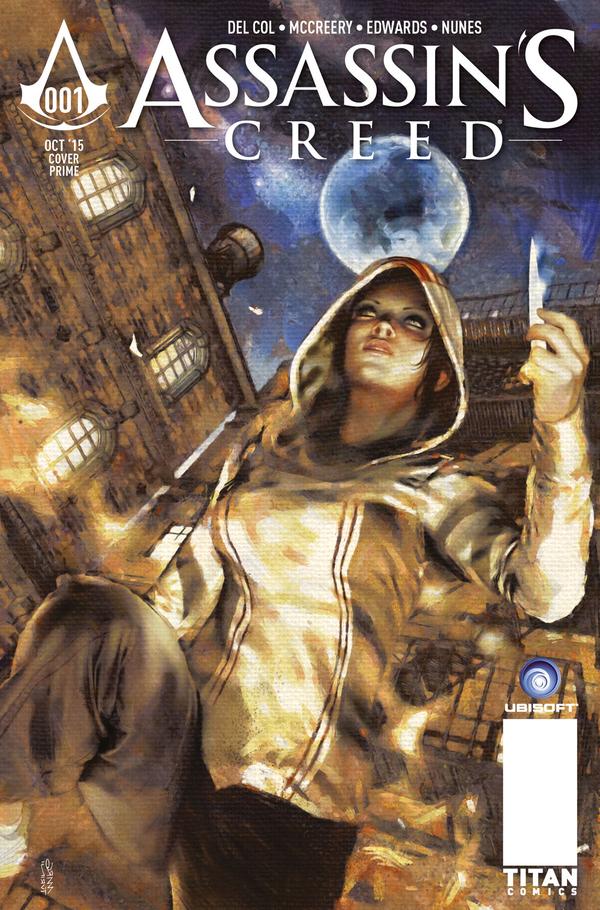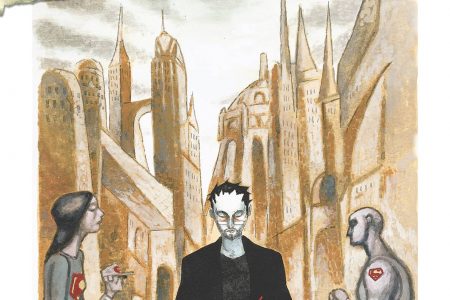Written by Anthony Del Col & Conor McCreery
Art by Neil Edwards
Letters by Richard Starkings and Comicraft’s Jimmy Betancourt
Colours by Ivan Nunes
Edited by Lizzie Kaye
Published by Titan Comics
1852. Great Basin Desert. California Gold Rush. A young woman in cowboy gear attacks a stagecoach to reclaim gold for the Maidu people who mined it. But this isn’t the genetic memories of a past life, as would be expected if you know anything about Assassin’s Creed – it’s a computer game, played on a virtual reality set by Charlotte de la Cruz, who prefers playing as the Brotherhood instead of the Templars because has an affinity for the Robin Hood vibe. She’s in San Diego for a job interview with World Share, some sort of global financial company, but she walks out when she can tell that the interviewer prefers a nepotistic solution to the job vacancy. She channels her anger into performing a bit of Robin Hood-style money transaction at the bank where she works, to help out a poor old lady in need, so it comes as something of a surprise to find two people, claiming to be from the Brotherhood, in her apartment. Not as much as surprise as when people crash through her door and try to kill her – the Brotherhood save her from these Templars and take her to their hideout. They inform her that the Helix System, the game she was playing and which was created by Abstergo, the world’s largest conglomerate, who sell it cheap so they can harvest all the data – sound familiar? – was a testing system, using actual memories instead of stories in the game, to find people with ancestral connections. The Brotherhood need Charlotte to access the memories of her ancestor from 1692, in Salem during the witch trials – a white man who doesn’t seem to have the same values as Charlotte, which she discovers rather nastily as she is violently de-synched from the Animus, the machine that allows the access of a person’s genetic past. However, this doesn’t hint at how dangerous it is for someone to try to change the history of an ancestor …
I really enjoyed Kill Shakespeare, the comic by Del Col and McCreery that made their name, and I’ve read a few Assassin’s Creed comics, but it was still a surprise at how much I enjoyed this comic. They have created a very intriguing protagonist in the form of Charlotte, a capable and intelligent woman who can let her passions get the better of her but who has a sense of right and wrong. The premise allows for a conflict for the character in the current political and financial climate, and I hope this aspect continues to thread its way through the rest of the series, and to see the development of Charlotte, who is a truly well-rounded character.
As well as the writing, the art deserves praise – Edwards conveys three separate timeframes with aplomb and draws realistic human beings in the modern world as well as the past. He manages to hold attention in scene-setting panels as well as the more flashy dynamic pages – the fact that the word ‘Assassin’ is in the title should be a suggestion that there will be violence, and there is some visceral action (I’ve still got the image of a throwing knife protruding from the front of an assailant’s skull in my memory, but in a good way). His artwork has come on a lot since I first saw it over five years ago (and didn’t think much of it), and I’m glad it was in the service of a well-written comic. Del Col and McCreery have crafted a very good first issue: it sold the premise, introduced a great new character, and I want to see how this tale continues. Recommended.
Disclosure: this book was provided as a PDF for review purposes.




